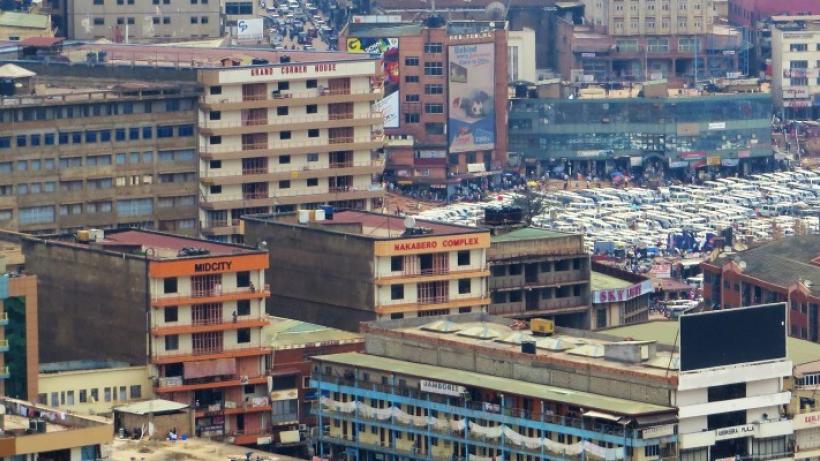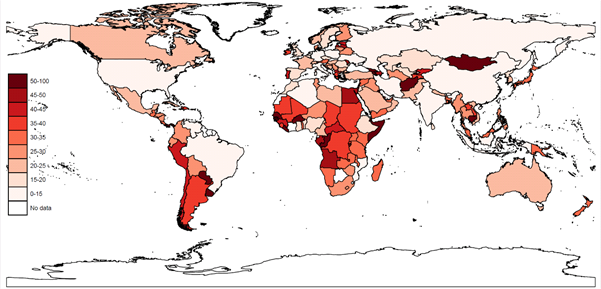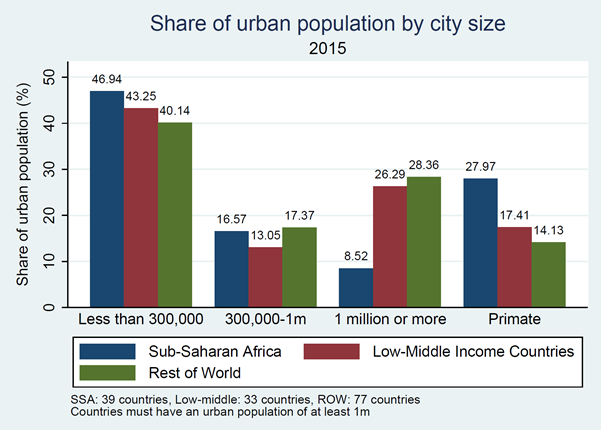
The costs of urban giants in sub-Saharan Africa
Several African cities have become veritable urban giants. Lagos and Cairo are each home to more than 20 million people, while others like Kinshasa, Luanda, and Dar es Salaam continue to grow at breakneck speed. The way these major cities grow will have tremendous impacts on future development in Africa.
Cities can be inherently productive spaces because they bring people and businesses together in close proximity. With urban density, firms can access larger consumer and supplier markets, workers can get better access to jobs, and governments can reach more citizens for a given set of infrastructure and services.
However, as economies develop, urban density tends to decline for two main reasons:
- Scale begins to reach its natural limit and the costs of density – such as congestion, noise, and pollution – start to make cities less attractive.
- Higher national incomes mean the public and private sector can invest more in hinterland regions. People get drawn away from the big, bustling metropolis and they flock towards secondary and smaller cities.
These opposing forces of urban growth are particularly prevalent in the rapidly growing megacities of Africa, where the benefits of scale are clearly met with strong ‘downsides of density’ (Ades and Glaeser 1995). Roughly 60% of Africa’s current urban population live in slums, compared to 34% in the rest of the developing world. In Dar es Salaam, 28% of residents live at least three to a room. In Abidjan, it is half the population. Housing, infrastructure, and other capital investments are consistently failing to keep pace with rapid urbanisation, making Africa’s cities crowded and uncompetitive (Lall et al. 2017).
Primacy across the globe
Economists tend to measure urban concentration using a proxy variable called primacy – the share of total urban population in a country’s largest city (Davis and Henderson 2003). Figure 1 maps primacy across the world using UN data for 2015. As a whole, Africa appears to be an outlier. Almost all sub-Saharan African countries have primacy rates above 30% and several above 50%.
Evidence from population censuses also show that primacy is a growing phenomenon in Africa. Across 34 countries primate cities have grown faster than any other urban areas. While secondary, tertiary, and small cities are converging in size, the largest cities are growing substantially.
Figure 1 shows that several countries in Latin America and East Asia also have rates of primacy that are as high if not higher than their African counterparts. In that sense, primacy may not only be an African phenomenon, but a developing country challenge.
 Figure 1: Primacy in 2015 (share of urban population in the largest city). (Source: UN World Urbanisation Prospects).
Figure 1: Primacy in 2015 (share of urban population in the largest city). (Source: UN World Urbanisation Prospects).
The key challenge
The real issue is not inherently with large cities per se, but that megacities in Africa are emerging despite low levels of national income. Low national income means less money to invest in infrastructure and institution building, which is needed to accommodate larger urban populations. This means congestion and its costs can quickly overwhelm the benefits of urban concentration.
A recent paper by Castells-Quintana (2016) highlights this. Using panel data from across the world for 1960-2010, Castells-Quintana shows that higher primacy will reduce a country’s GDP unless at least 50% of its urban residents have access to basic services such as sanitation and electricity. Most African countries fall far below that threshold.
Primacy and the African city system
Primacy does not just affect the largest city but it also has implications for the entire country. Figure 2 gives an indication of this. It charts the distribution of population across different world regions. Several interesting facts on Africa emerge:
- The urban population predominantly lives either in the country’s largest city or its urban areas with under 300,000 people.
- The share of urban citizens in cities of one million or more is much lower in Africa than elsewhere. This implies a lack of secondary city development. This is important since some consider secondary cities to be better facilitators of labour mobility and job creation in developing countries (Ferre et al. 2010). This is because secondary cities are more numerous and closely distributed to large rural hinterlands, better facilitating the transition from rural to non-rural activities.
 Figure 2: Urban population distribution by region (2015). (Source: UN World Urbanisation Prospects)
Figure 2: Urban population distribution by region (2015). (Source: UN World Urbanisation Prospects)
Why might secondary cities be lagging?
Aside from the downsides of density, primate cities tend to monopolise economic and public investment in their respective countries, thereby straining the whole city-system. Typically, secondary cities are also the recipients of industries like manufacturing, which deconcentrate away from the largest cities over the course of development. However, weaknesses in the industrial sector of large African cities may in turn diminish the role for secondary cities.
Secondary cities may also rank low on the priorities and budgets of central governments if decision-making power is concentrated in the capital city. This means service provision and management of infrastructure can be particularly weak, further stalling their productivity growth. Unless these cities become more competitive, Africa’s urban growth will likely continue to be absorbed by primate cities in the coming decades, further accentuating the costs of congestion.
Policy implications
Addressing Africa’s urbanisation challenges will require a fine balance between managing the costs of primacy and supporting the growth of emerging cities. Whilst the downsides of density are immediate and tangible, the policy responses to boost hinterland regions are less defined. Improving the competitiveness of these cities could alleviate pressure on some of Africa’s urban giants whilst making the region a more attractive environment for global investment.
References
Ades, A and E Glaeser (1995), “Trade and circuses: Explaining urban giants”, NBER, Working paper No. 4715
Castells-Quintana, D (2016), “Malthus living in a slum: Urban concentration, infrastructure and economic growth”, Journal of Urban Economics.
Davis, J and J Henderson (2003), “Evidence on the political economy of the urbanisation process”, Journal of Urban Economics, 53(1): 98-125.
Ferre, C, F Ferreira, P Lanjouw (2010), Is there a metropolitan bias? The inverse relationship between poverty and city size in selected developing countries, Policy research working paper, no. WPS 5508, Washington, DC: World Bank
Lall, S, J Henderson, A Venables (2017), Africa’s cities: Opening doors to the world, Washington, DC: World Bank.
Editor’s Note: This blog is part of the IGC’s 10 year celebration series. This blog is linked to our work on cities driving growth.

